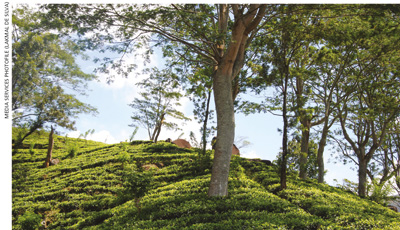THE ENVIRONMENT
PROTECTING OUR RAINFORESTS
Janaka Perera emphasises the need to preserve the island’s biodiversity
Over half the planet’s species are found in tropical forests including those of Sri Lanka. The humid tropical forest environment is fragile and extremely complex with myriad life forms that depend on one another.
In an intricate cycle of life, the forest efficiently recycles all the living material it has including plants, animals and microorganisms. If destroyed, it may be difficult or impossible for such a complex ecosystem to be regenerated.
Sri Lanka’s ancient tradition of protecting plant and animal life dates as far back as the 3rd century BC when Buddhism was introduced to the country. This was a land of lush green forests nurtured by high temperatures and abundant rainfall, and lengthy periods of growth.
Over the past century or so however, these natural resources have been destroyed along with many of their material benefits. Deforestation has seriously diminished timber supplies and made the soil less fertile, water supply more erratic, and floods and landslides more frequent and severe. It has also posed a major threat to the survival of the island’s rich biodiversity.
 Although they cleared large areas of virgin jungle land for coffee, tea and rubber plantations, the British colonists later realised the long-term importance of arresting indiscriminate forest destruction. In 1885, Forest Conservation Ordinance No. 10 saw some protection given to forests (primarily for sustainable wood production) and wildlife in sanctuaries.
Although they cleared large areas of virgin jungle land for coffee, tea and rubber plantations, the British colonists later realised the long-term importance of arresting indiscriminate forest destruction. In 1885, Forest Conservation Ordinance No. 10 saw some protection given to forests (primarily for sustainable wood production) and wildlife in sanctuaries.
Four decades following independence, the National Heritage Wilderness Areas Act No. 3 of 1988 established a national heritage protection scheme for forests that are home to unique ecosystems and outstanding natural features.
The island’s lowland is home to tropical rainforests at an elevation of 1,000 metres in the southwestern region. Along with thousands of years of isolation from mainland India, the year-round warm and wet climate has resulted in the evolution of numerous plants and animal species that can only be found in these rainforests.
Of these, the Sinharaja Forest Reserve is among the most famous – this tropical rainforest is a living heritage site with great biodiversity and a large proportion of its flora is endemic to the country while some are endemic to the reserve.
Today, it is a UNESCO World Heritage Site – and one of the few virgin forests left in the world. Streams, springs, rivers, waterfalls, leopard, monkeys, butterflies and moths, rare trees, valuable shrubs and medicinal herbs are all found under its arboreal canopy. A trek along prescribed paths offers nature lovers a never to be forgotten experience of sights and sounds.
Attempts to compromise the Sinharaja Forest Reserve should not be permitted. Any overt or covert attempt to build dwellings, or introduce plantations or industry, within the so-called boundary areas of such natural reserves must be prevented at all costs.
Focussing on these issues is the Rainforest Protectors of Sri Lanka, a nonprofit volunteer organisation with a mission to protect the remaining rainforests in the country – such as Sinharaja and Kanneliya-Dediyagala-Nakiyadeniya rainforests – through conservation projects and environmental activism.
And the letter this group wrote to President Maithripala Sirisena on 9 February regarding mini-hydro projects is significant.
It states: “The recent explosion of mini-hydro projects in the environmentally sensitive and biodiversity hotspot wet zone of Sri Lanka has resulted in many ecological and social issues along with severe impact[s] to tourism, thus costing the country vital foreign exchange.”
The letter also states that these projects have destroyed over 1,000 kilometres of rivers and stream ecosystems without providing a solution to the energy crisis due to their inability to generate power during droughts.
This has resulted in abrupt power shortages and the need to purchase expensive diesel power – such as from March to June 2017 when the capacity of all hydro plants was estimated to be a meagre eight percent.
The organisation avers that “contrary to perceptions, mini-hydro is more expensive than solar and wind projects due to its low plant factor – and with climate change, this is absolutely no solution for the future.”
It is working to acquire and permanently protect the remaining privately held rainforest land adjoining existing protected reserves, which are in danger of being clear-cut for tea and oil palm plantations. It also plans to secure the buffer zones, as well as create vital biodiversity corridors, to facilitate the movement of wildlife and increase genetic diversity.
As part of this initiative, it also aims to protect and reconnect the lost rivers of Sinharaja, which now flow outside its core boundaries due to encroachment and fragmentation.
With the increased focus on environmental protection and consequent policy changes, the problem of deforestation has been greatly reduced. This offers hope for the future.






Manmade destruction of rainforests can be traced as early as the era of English rulers in Sri Lanka, as the colonial invaders cleared forests to cultivate tea estates for the commercial crop. Most of them called themselves English planters and contributed to the beginning of depletion of forests, loss of habitat for wildlife, killing of elephants etc., in the country’s central region. This was the first destruction of ecosystem which took place at the official level.
Ecosystems are vulnerable due to the demand for electricity. Mini hydro power plants are supposed to generate power at a lower cost but we’re actually losing more. As climate change and loss of forest cover heats the earth to an unbearable level, we may be compelled to spend more to protect the soil of Sri Lanka from rising heat levels to maintain earth-life balance.